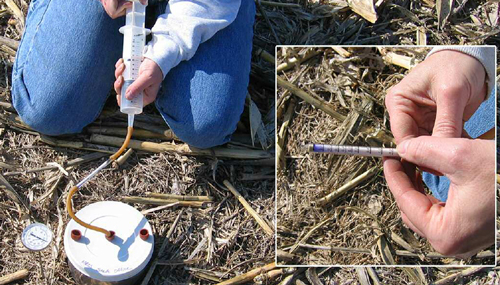Respiration
What it is: Carbon dioxide (CO2) release from the soil surface is referred to as soil respiration. This CO2 results from several sources, including aerobic microbial decomposition of soil organic matter (SOM) to obtain energy for their growth and functioning (microbial respiration), plant root and faunal respiration, and eventually from the dissolution of carbonates in soil solution. Soil respiration is one measure of biological activity and decomposition. The rate of CO2 release is expressed as CO2-C lbs/acre/day (or kg/ha/d). It can be measured by simple field methods or more sophisticated field and laboratory methods. During the decomposition of SOM, organic nutrients contained in organic matter (e.g., organic phosphorus, nitrogen, and sulfur) are converted to inorganic forms that are available for plant uptake. This conversion is known as mineralization. Soil respiration is also known as carbon mineralization.
Why it is important: Soil respiration reflects the capacity of soil to support soil life including crops, soil animals, and microorganisms. It describes the level of microbial activity, SOM content and its decomposition. In the laboratory, soil respiration can be used to estimate soil microbial biomass and make some inference about nutrient cycling in the soil. Soil respiration also provides an indication of the soil's ability to sustain plant growth. Excessive respiration and SOM decomposition usually occurs after tillage due to destruction of soil aggregates that previously protected SOM and increased soil aeration. Depleted SOM, reduced soil aggregation, and limited nutrient availability for plants and microorganisms can result in reduced crop production in the absence of additional inputs. The threshold between accumulation and loss of organic matter is difficult to predict without knowledge of the amount of carbon added.
Specific problems that might be caused by poor function: Reduced soil respiration rates indicate that there is little or no SOM or aerobic microbial activity in the soil. It may also signify that soil properties that contribute to soil respiration (soil temperature, moisture, aeration, available N) are limiting biological activity and SOM decomposition. With reduced soil respiration, nutrients are not released from SOM to feed plants and soil organisms. This affects plant root respiration, which can result in the death of the plants. Incomplete mineralization of SOM often occurs in saturated or flooded soils, resulting in the formation of compounds that are harmful to plant roots, (e.g. methane and alcohol). In such anaerobic environments, denitrification and sulfur volatilization usually occur, contributing to greenhouse gas emissions and acid deposition.
What you can do: The rate of soil respiration under favorable temperature and moisture conditions is generally limited by the supply of SOM. Agricultural practices that increase SOM usually enhance soil respiration.
The following practices have the potential to significantly improve SOM and indirectly soil respiration when other factors are at an optimum:
- Conservation tillage (no-till, strip-till, mulch till, etc.)
- Application of manure and other organic by-products
- Rotations with high residue and deep-rooted crops
- Cover and green manure crops
- Irrigation or drainage
- Controlled traffic
For more information go to Soil Management Practices.
Measuring respiration:
Soil respiration is measured using the Draeger-Tube® method described in the Soil Quality Test Kit Guide, Chapter 2, p 4 - 6. See Section II, Chapter 1, p 52 - 54 for interpretation of results.

Photo: Draeger-Tubes® are used to measure CO2 released from the soil surface as an indicator of decomposition and soil respiration.
Parkin T.B., J.W. Doran, and E. Franco-Vizcaíno. 1996. Field and Laboratory Tests of Soil Respiration. In: Doran J.W., A.J. Jones, editors. Methods for assessing soil quality. Madison, WI. p 231-45.
